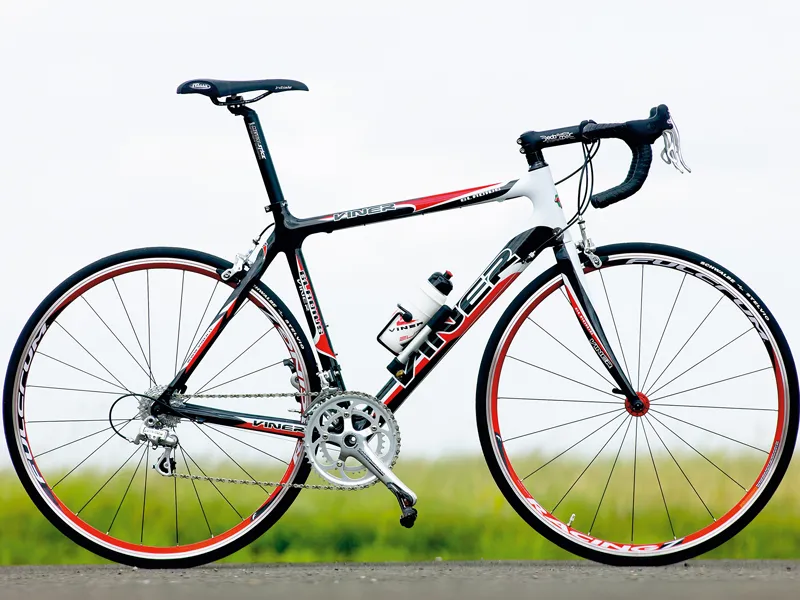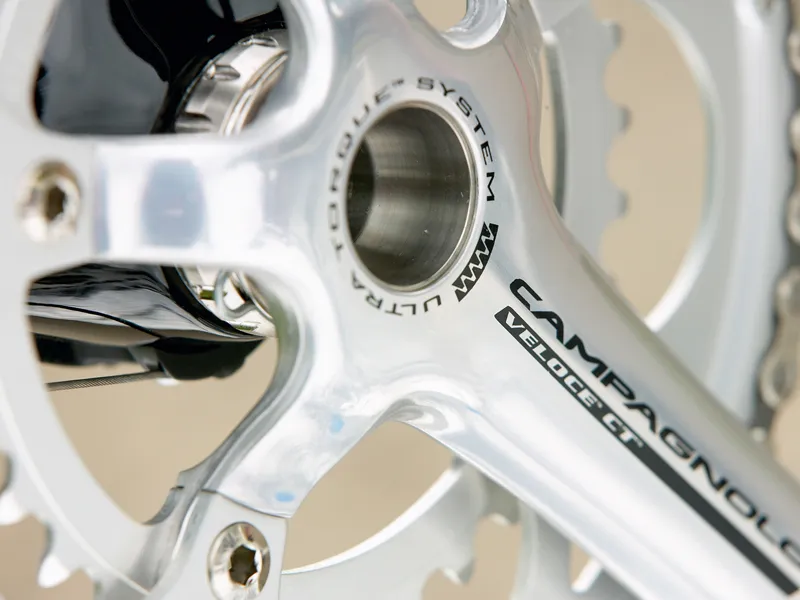Italian heritage, Taiwanese manufacturing and road racing design combine in this sportive-smooth road warrior.
Viner's most affordable carbon fibre bike, the Gladius is produced exclusively for the UK to compete head-on with web-based companies. Its shorter head tube makes for a racier position than pure sportive bikes, but its shock-dampening ride will appeal to sportive riders looking for a less-fatiguing long-ride machine.
Ride & handling: deceptively smooth, stable and surefooted
The Gladius is rewarding to ride at a steady pace, though its smooth and dampened ride character can make it feel slower than it really is. A glance at the cycle computer was enough to disprove this illusion.
The Gladius got a slightly mixed reception depending on riders’ preferences. Testers who favour bikes with a stiff ride felt that the Gladius lacked the excitement of a Scott CR1 or Storck CD1.0 when ridden aggressively. Testers with a more relaxed riding style felt that the smooth character made it less intimidating to ride fast downhill. That’s especially noticeable especially compared to some German-designed bikes that are built purely for stiffness.
On this basis the versatile Gladius is well suited to sportives. On these longer, fast rides, a bike's ability to dissipate vibrations becomes a factor towards the end of the event. The low riding position will not suit those who have back problems when climbing, though.
The steering and excellent lateral stiffness to the front end of the bike mean that it can be hustled past slower riders on descents and the quickness with which direction changes can be made won't disappoint riders who want their piece of glory in front of spectators in the dash for the finish line of a sportive.
ArrayFrame: one-piece Taiwanese carbon, nice graphics
The Taiwanese-made one-piece frame weighs around 300g more than the recently tested class-leading Scott CR1 Team frame but is lighter than the 1,477g/3.3lb PBK Team frame.
The wishbone back-end looks like it was designed as a homogenous part of the frame rather than tacked on as an afterthought.
The forks have an aluminium steerer tube and fully integrated headset bearings, together with a complement of spacers to either raise or reduce the handlebar height.
Viner have gone with an English bottom thread instead of the with the 'double-right-hand' Italian style. That should ensure that the bearing cups remain tight in the frame.
The hugely oversized down-tube and bold Viner logo conspire to make it appear smaller than it really is. The attractive head-tube graphics and carbon background finishing layer are applied in their Italian factory and there are frame-protector strips to preserve the paintwork.
Four frame sizes are available and we recommend that sizing be based on the top-tube dimensions that range from 52cm on the S, 53.7cm on the M, 56cm on the L and 58cm on the XL. A frame, fork and headset package is also available for £849.
Wheels: great value but for the joint
The Fulcrum Racing 7 wheels are appearing with ever greater frequency on bikes around the £1,000-£1,350 price and the red wheels work well with the Viner's red and white frame graphics.
The cartridge-bearing hubs are essentially 'borrowed' from the Campagnolo Mirage group and have a red anodised surface treatment that makes them look far more expensive than they are.
The R7s are currently around the £120 mark when bought as a pair and the hubs have a long-standing reputation for total reliability.
While we love almost every aspect of these wheels, the rim ends are joined by a internal pin instead of the more usual weld. It’s almost impossible to get perfect alignment of this joint, and that results in an annoying 'bump, bump' noise on every wheel revolution when applying the brakes. The abrasive effect of applying the brakes in wet weather should have worn the ends down sufficiently to improve matters but the problem remained.
At a time when the summer storms have washed a lot of detritus on to the road surface the Schwalbe Stelvio tyres resisted cuts well and we picked up just one puncture right at the end of testing.
Equipment: Mostly Italian but some heavy choices
Aside from the Schwalbe tyres from Germany, the Gladius has an all-Italian spec. The Campagnolo Veloce components are comparable in terms of weight with the more widely used Shimano 105 groupset.
The Italian Deda finishing kit and saddle are on the heavy side compared to many bikes up to and around this price. The anatomical profile of the Deda Big Piega oversized handlebars helps to ease pressure on the hands' ulna nerves on longer rides, and the deep drops help you to adopt an aerodynamic position.
The Deda four-bolt Quattro stem is notably stiffer than some of the lighter and more expensive stems on the market. It can be flipped upside-down to provide a more upright riding position for those who need it.
The Deda Metalstik 31.8mm seatpost has a simple clamp that makes saddle angles easy to adjust. A 27.2mm seatpost combined with a shim would improve comfort, though, by providing more fore/aft compliance.
The new 315g Selle Italia Initiale saddle was a hit with the testers. The slip-proof top helps to prevent the rider from sliding forward on the saddle in wet weather. It has has just the right amount of 'give' in the foam to provide support along its entire length.
Verdict: jack-of-all-trades with web value
This jack of all trades is ideally suited to the sportive rider looking for a lower riding position rather than a purely sportive-orientated mount such as the Specialized Roubaix or Cannondale Synapse.
The Gladius achieves what it sets out to do by very nearly equalling what most of the web-based companies have offered us in terms of component spec and exceeding them in terms of brand identity, so if that is an essential ingredient to your enjoyment of cycling. Buy one while stocks last.
Who’s Viner?
The Viner (pronounced 'veener') factory in Tuscany has just celebrated its 60th year of bicycle production. In terms of visibility in the UK, however, the company has fallen some way behind the big names since the death in the 1970s of UK importer Italo Berigliano. Happily, Viner was reintroduced to the UK about two years ago.
While this bike is listed here as a 2007 model, it's still available at www.vinerbikes.com.



